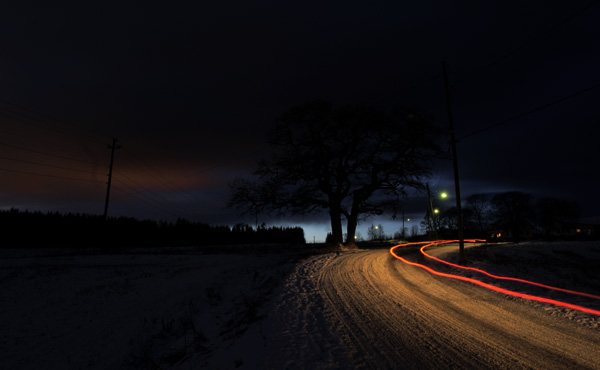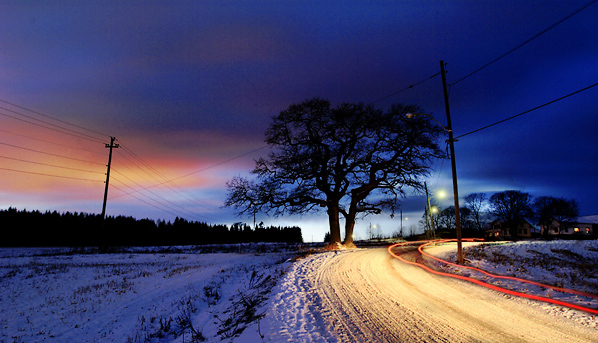| Nikon D2X Digital Camera
Reviewed |
|
|
| by Bjørn
Rørslett |
|
9.
Summing Up
In my opinion, Nikon D2X heralds the end of 35 mm
film for virtually all shooting assignments for a Nikon user. You get an image quality
unsurpassed by today's or even tomorrow's film-based technology
for the venerable 24 x 36 mm format. This is the first DSLR used
by me which can rendered wide sweeps of landscape with tangible
and breathtaking clarity of detail. However, any camera system
descending from 35 mm stock inherits a limit to the detail which
can be captured for landscape work, because of the relatively
short focal lengths typically deployed with these cameras. Short
focal lengths translate into low magnification and implies
details also will be rendered small. So landscape work is still a
domain in which larger format cameras prevail by virtue of their
bigger capturing areas and the accompanying longer focal lengths.
This is not something particular to Nikon DSLR, it applies to
other makers' offerings as well. That being said, D2X is
certainly capable of bringing forth whatever detail the currently
mounted lens can deliver.
D2X is also the most
unforgiving image recording instrument I've ever used. If there
is any optical flaw or aberration of the image projected by your
lens, the D2X will show the defect with merciless clarity.
Chromatic aberration (CA) will become a catchword of nightmarish
importance, if you want to produce poster-sized prints. Lenses
you believed were just about perfect will suddenly appear devoid
of their former splendour, whilst the real optical gems will take
on a magical shine on their own.
If you rely on sloppy and
haphazard shooting techniques, D2X will teach you a lesson you'll
not likely to forget. Put simply, this is a pinnacle in terms of
its imaging achievement and not every photographer will be able
to scale that obstacle. On the other hand, its innate quality and
dynamic range may nevertheless save the day.
Pastoral Oak Tree at Dusk
|
 |
| When you commit the
inevitable user error, D2X can come to the rescue. Here,
the camera was unintentionally left on "M"
setting so it didn't adjust its exposure properly to the
rapidly fading light of this pastoral scene. The night
skies together with peripheral areas of the ground are
underexposed at least 4 stops. |
 |
| Even from
such a grossly underexposed image, you can get a
satisfactory end result Nikon D2X, AFS-Nikkor 17-35 mm f/2.8
lens, 25 sec exposure at f/8, 100 "ISO"
© Bjørn Rørslett/NN
|
The arrival of the current top model, D2X,
means we finally can evaluate Nikon's approach to digital
photography and the efforts to make DX their "new"
standard for digital photography.
The DX format has shown
real muscle with the introduction of the D2X, transcending the
quality expectation for this tiny format. Pitched against the reigning DSLR champion, Canon 1
DS Mk.II, D2X comes out on top with better performance in nearly
all aspects. This shows that Nikon's approach to digital SLR
technology with focus on the "DX" format, stubborn and
seemingly in conflict with the current perception of "full
frame" as the only viable solution, in the end might just be
the more prudent move after all.
You can get truly impressive and stunning
image quality from a D2X shot, but this - obviously - requires
using the best lenses from the vast arsenal available in
"F" mount. Without changing their long-standing camera
bayonet mount, Nikon has managed to develop telecentric designs
for their widest angle lenses, so some inherent drawbacks of
current digital recording technology (vignetting and chromatic
flaws into the corners of the frame) can be addressed or
circumvented. The resolving capacity of D2X, however, clearly
shows that although vignetting issues are solved, some vestiges
of chromatic aberration are unavoidable despite all the optical
wizardry poured into these modern designs. Whether or not this is
objectionable depends largely on the scene captured by the
camera, and the degree of enlargement you plan for the image.
Because CA is more clearly defined on D2X images, it should be
easier to remove as well. The affected image areas with CA issues
do not "bleed" into the neighbouring pixels to the
extent we see with lesser cameras. Also noteworthy is that the CA
issue is not between DX vs non-DX lenses per se, but
might be lens specific. Thus, AFS 17-55 DX does have slightly
more CA at 17 mm than the legendary AFS 17-35 Nikkor, the latter
of which is non-DX. However, for the very short focal range the
DX lenses really show the advantage of their telecentric design.
One just have to shoot with 12-24 DX set to 14 mm vs the 14 mm
f/2.8 Nikkor to realise this.
For the longer focal lengths, most quality
lenses from 28 up to 135 mm should perform well on the D2X. Older
telephoto lenses, those manual ED-IF lenses with the classic 8/6
(elements/groups) optics, can be expected to show some corner CA
as well, in particular if used with teleconverters, so you should
deploy the new generation AFS/AFS-VR in order to extract maximum
image quality from the D2X with them. Alternatively, you can
familiarise yourself with post-processing correction software
such as the freely available PanoTools.
I feel time, unavoidably and unequivocally,
now has come to include the post-processing software as an
integrated part of the entire photographic workflow, to an extent
where the final touching-up of the image is left to the computer
software. After all, when the EXIF metadata tells the software
all there is to know about the shooting and the lens employed,
surely the program can rearrange the pixel data to minimise any
residual aberration. As an extension of this we should urge the
manufactures to publish the correction data openly, to the
benefit of the digital photographer community and software
companies in general.
Meanwhile, fire up your Capture software
and enjoy the impressive image quality now within reach with the
Nikon D2X. This will be my personal bread-and-butter camera for
nearly every conceivable application in the near future. Nikon's
digital cameras have, at last, come of age. It remains for the
photographer to make his or her visions come alive with the
excellent D2X tool now at hand. At least you have probably the
best performing DSLR available today.
Acknowledgements
Several people helped me complete this
review article. Thanks go to the staff at Interfoto (Norwegian
national Nikon importer and dealer) for giving me access to
production-level cameras at an early stage, to Kai E. Jensen for
his assistance in conducting the shoot-out between Nikon D2X and
Canon 1 DS Mk.II, to Ola-E. Hofshagen for his critical reading
and analysis of the manuscript, and to my girl friend Ruth
Eckhoff for much needed moral support during the strenuous last
stage of writing.

